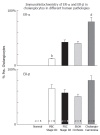Estrogens and the pathophysiology of the biliary tree
- PMID: 16773710
- PMCID: PMC4087569
- DOI: 10.3748/wjg.v12.i22.3537
Estrogens and the pathophysiology of the biliary tree
Abstract
The scientific framework concerning estrogen effects on different tissues has expanded enormously during the last decades, when estrogen receptor (ER) subtypes were identified. Estrogens are not only essential for the female reproductive system, but they also control fundamental functions in other tissues including the cardiovascular system, bone, brain and liver. Recently, estrogens have been shown to target the biliary tree, where they modulate the proliferative and secretory activities of cholangiocytes, the epithelial cells lining bile ducts. By acting on both estrogen receptors (ER-alpha) and (ER-beta) subtypes, and by activating either genomic or non-genomic pathways, estrogens play a key role in the complex loop of growth factors and cytokines, which modulates the proliferative response of cholangiocytes to damage. Specifically, estrogens activate intracellular signalling cascades [ERK(1/2) (extracellular regulated kinases (1/2), PI3- kinase/AKT (phosphatidylinositol-3' kinase/AKT)] typical of growth factors such as insulin like growth factor (IGF1), nerve growth factor (NGF) and vascular endothelial growth factor (VEGF), thus potentiating their action. In addition, estrogens stimulate the secretion of different growth factors in proliferating cholangiocytes. This review specifically deals with the recent advances related to the role and mechanisms by which estrogens modulate cholangiocyte functions in normal and pathological conditions.
Figures




References
-
- Roskams TA, Theise ND, Balabaud C, Bhagat G, Bhathal PS, Bioulac-Sage P, Brunt EM, Crawford JM, Crosby HA, Desmet V, et al. Nomenclature of the finer branches of the biliary tree: canals, ductules, and ductular reactions in human livers. Hepatology. 2004;39:1739–1745. - PubMed
-
- Crawford JM. Normal and abnormal development of the biliary tree. In: Alpini G, Alvaro D, Marzioni M, LeSage G, LaRusso NF, et al., editors. The Pathophysiology of Biliary Epithelia. Georgetown, TX: Landes Bioscience; 2004. pp. 1–13.
-
- Saxena R, Theise ND, Crawford JM. Microanatomy of the human liver-exploring the hidden interfaces. Hepatology. 1999;30:1339–1346. - PubMed
-
- Alvaro D. Biliary epithelium: a new chapter in cell biology. Ital J Gastroenterol Hepatol. 1999;31:78–83. - PubMed
Publication types
MeSH terms
Substances
Grants and funding
LinkOut - more resources
Full Text Sources
Miscellaneous

